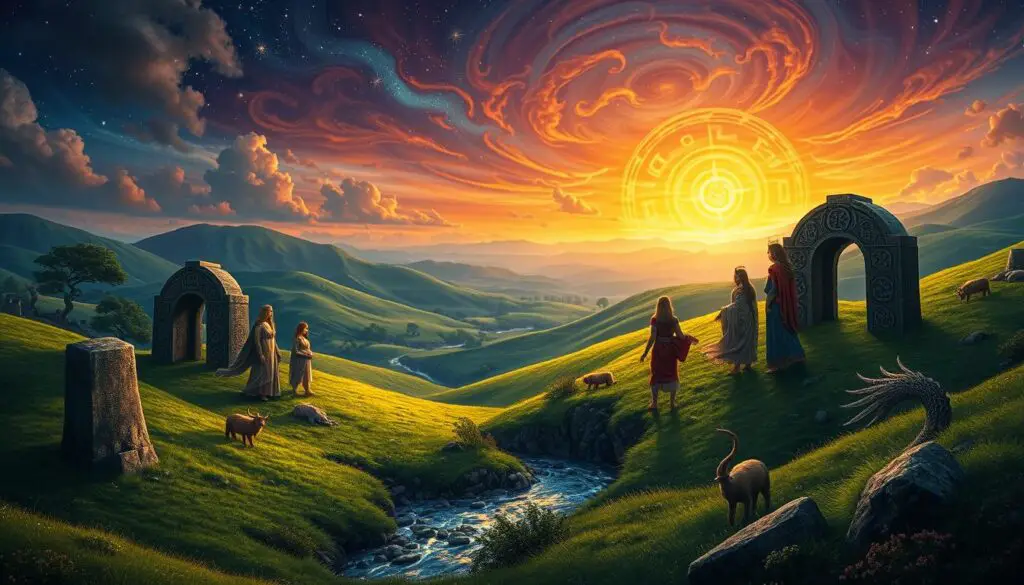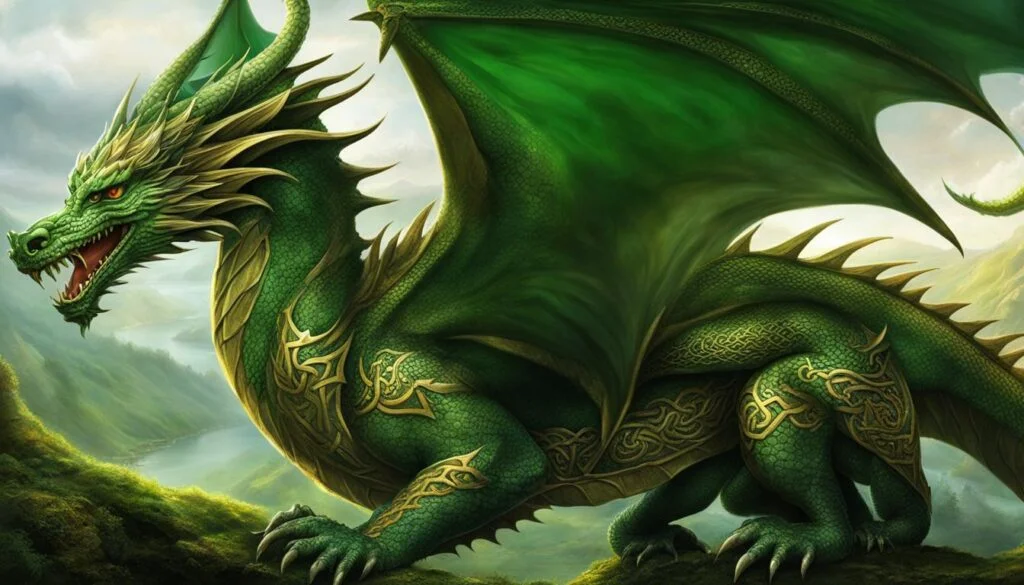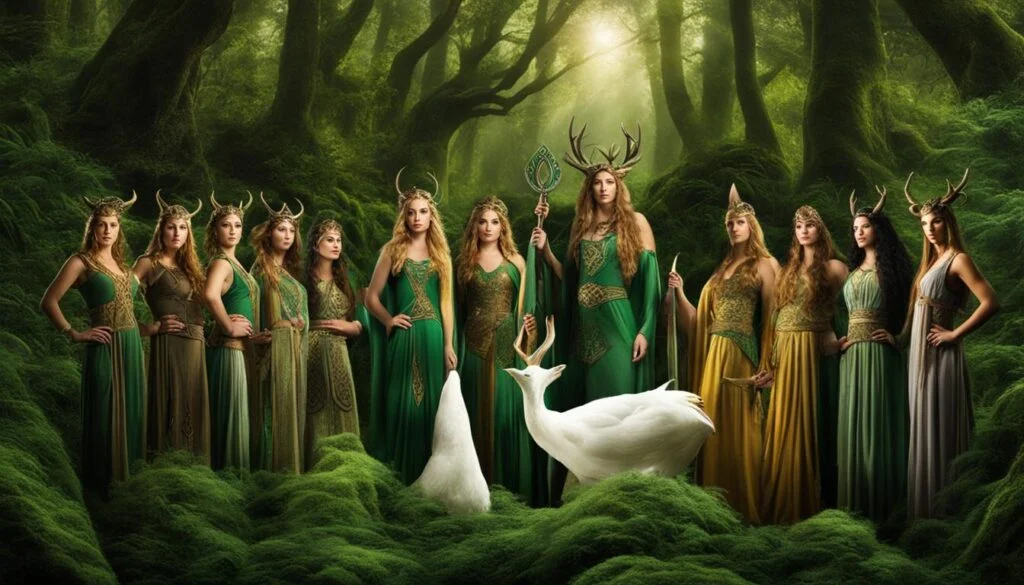The Tuatha Dé Danann were magical beings from Irish mythology. They lived in the Otherworld but often visited the human world.
They are tied to famous places in Ireland, like Newgrange, and marked a special time in history.
Legend says they came to Ireland under dark skies, lasting three days.
They won the First Battle of Mag Tuired against the Fir Bolg. This made them the rulers.
Important figures like Nuada Airgetlám, The Dagda, and Lugh were key. They were known for their magic and skills, adding to Irish mythology.
Later, they faced the Milesians, who were the first Gaels in Ireland. This led to sharing the land.
The Tuatha moved to sídhe mounds and became the aes sídhe, or fairies. Their stories still enchant us, adding to Ireland’s rich folklore.
Key Takeaways
- The Tuatha Dé Danann were a mythical race associated with ancient Ireland.
- They arrived in a shrouded darkness, significantly impacting Irish history.
- These supernatural beings are linked with historic sites like Newgrange.
- Notable members included Nuada Airgetlám, The Dagda, and Lugh.
- They possessed magical treasures such as Dagda’s Cauldron and the Stone of Fal.
Introduction to the Tuatha Dé Danann
The Tuatha Dé Danann were a magical group in Irish stories. They were called the “tribe of gods.”
Their name comes from “dé,” meaning “god.” They were seen as gods and goddesses.
They came from Danu, a figure linked to the Welsh goddess Dôn and the Hindu Danu.
This shows they shared stories with other cultures in old Ireland.
Origins and Meaning
The Tuatha Dé Danann were known as “god-folk.” Their name comes from the goddess Danu.
It shows they were gods and the ancestors of the Irish people.
They came from the clouds and filled Ireland with magic. They made the sun dim for three days.
This showed their magical power and set them up as important in stories.
Significance in Irish Mythology
The Tuatha Dé Danann ruled Ireland from 1897 B.C. to 1700 B.C. They had a lot of power over the land and people.
They brought four treasures to Ireland: the ‘Stone of Fál’, the ‘Magic Sword of Nuada’, the ‘Spear of Lugh’, and the ‘Cauldron of Dagda’.
These treasures brought good luck and protection.
They did more than just rule. They made the land fertile, helped choose the right rulers, and created a perfect society.
When Christianity came, writers tried to fit them into the new beliefs. They were seen as fallen angels or powerful magicians.
Names like The Dagda, The Morrígan, and Lugh show how old stories and new beliefs mixed together.
Pre-Christian Gaelic Ireland’s Deities
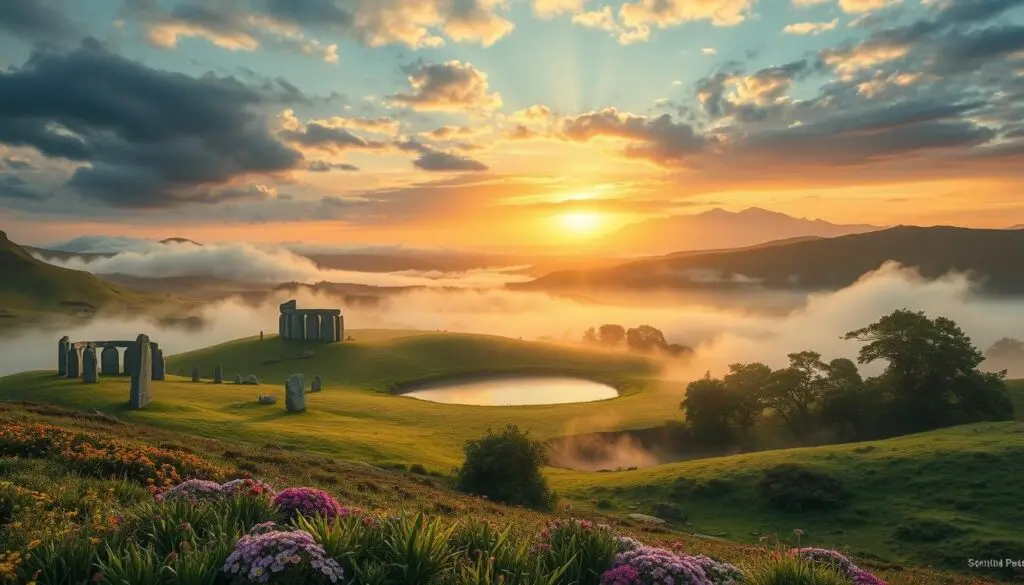
In pre-Christian Ireland, the Tuatha Dé Danann were a powerful group.
They were seen as perfect humans with control over nature and could change shapes.
People worshipped them for their power over the land and nature.
Pantheon and Practices
The Tuatha Dé Danann had many important figures like The Dagda, The Morrígan, Lugh, and Brigid.
They were seen as rulers, healers, and more, with magical powers. People believed they could change their luck with magic.
Transition to Christianity
When Christianity came, the Tuatha Dé Danann changed. They were seen as special people with amazing skills, not gods.
This change kept their stories alive in a new way, fitting with Christianity.
The Mythological Cycles
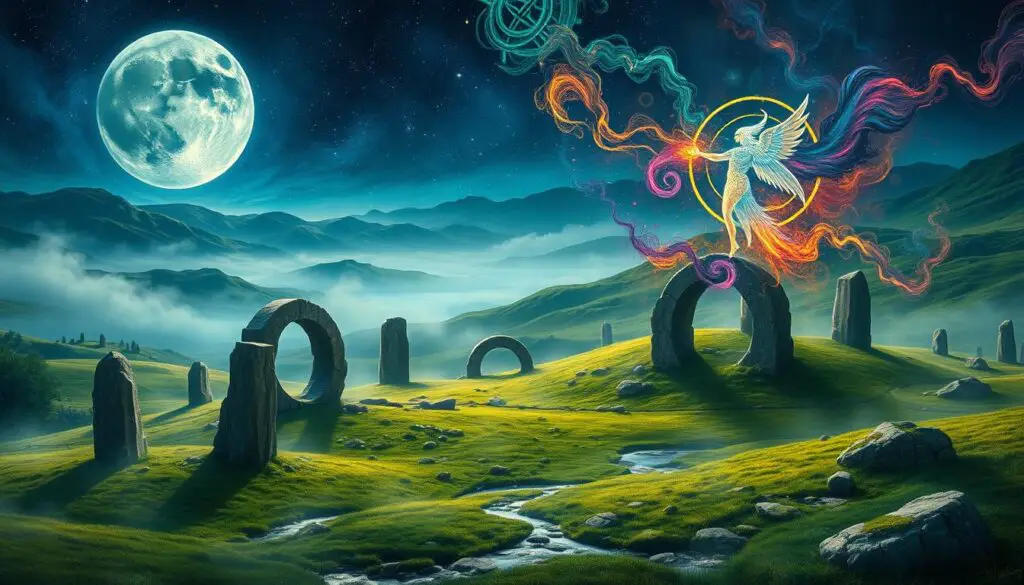
Ireland’s mythological cycles are like a big tapestry. They bring together many Irish epic tales.
These tales come from the ancient Tuatha Dé Danann. They tell of immortal deeds, big battles, and wisdom of these magical beings.
Mythological Cycle
This cycle is also called the Cycle of the Gods. It’s full of stories about the Tuatha Dé Danann, Fomorians, and Fir Bolg.
Important texts like the Lebor Gabála Érenn and Cath Maige Tuired tell of their origins and big battles.
The Tuatha Dé Danann are seen as godlike, even though Christian scribes didn’t call them gods.
Ulster Cycle
The Ulster Cycle is another important part of Irish tales. It focuses on heroes like Cú Chulainn.
These stories are known for their bravery, conflict, and love. They give us a peek into ancient Ireland’s heroic world.
Fenian Cycle
The Fenian Cycle is full of legends. It’s about Fionn mac Cumhaill and his warriors, the Fianna.
These tales show their adventures and magical skills. They mix human stories with the magic of the Tuatha Dé Danann.
King Cycle
The King Cycle looks at the lives and rules of ancient Irish kings. It mixes history with legend.
This cycle shows how the Tuatha Dé Danann shaped Ireland’s early landscape and government.
These cycles keep the Tuatha Dé Danann’s story alive. They still touch modern people and keep a big place in Irish culture.
Each cycle adds its own stories and characters to the mix. This mix of myth and history still inspires us today.
The Arrival in Ireland
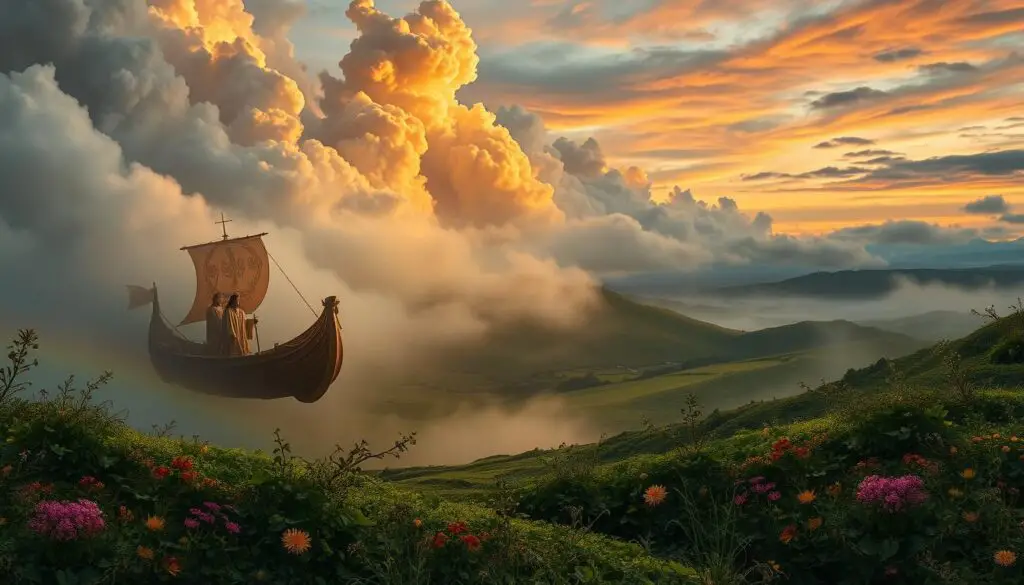
The Tuatha Dé Danann came to Ireland in a big way. They brought 300 ships, led by King Nuada.
Their trip was magical and mysterious. They came from four Northern Cities and brought wisdom and treasures.
The Journey from the Northern Cities
The Tuatha Dé Danann traveled from the Northern Cities. These cities were full of learning and magic.
They moved to Ireland, ready to claim the land.
They brought treasures like the Lia Fáil and the Spear of Lugh. These treasures showed they were powerful.
They were ready for battles to win Ireland.
The Battle of the Fir Bolg
When they arrived, they fought the Fir Bolg. This battle was hard and important. The Tuatha Dé Danann won, pushing the Fir Bolg to the west.
King Nuada led bravely, even after losing his hand. He got a silver hand back. The Tuatha Dé Danann became the rulers of Ireland.
The Battle of Mag Tuired
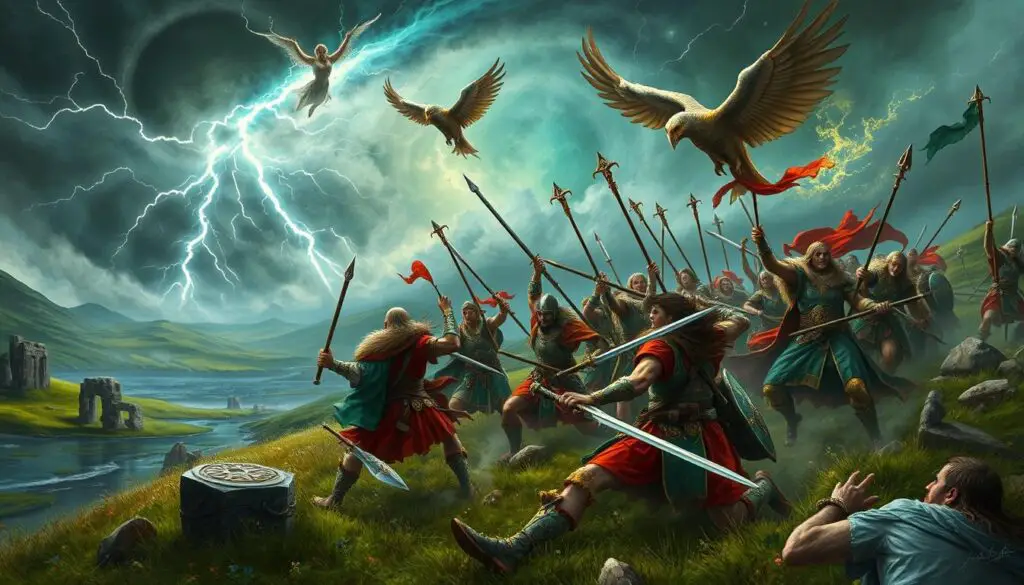
The Battle of Mag Tuired is a big part of Irish stories. It shows the strength and bravery of the Tuatha Dé Danann.
They fought against the Fir Bolg and the Fomorians.
First Battle
The First Battle of Mag Tuired happened near County Mayo. The Tuatha Dé Danann fought the Fir Bolg.
It lasted four days and was very intense.
King Nuada lost his hand in the battle. He got a silver hand instead.
This made him *Nuada Airgetlám* (Nuada of the Silver Hand).
This made Nuada have a hard time leading. But, the Tuatha Dé Danann won the battle.
They beat the Fir Bolg and took over Ireland.
Second Battle
The Second Battle of Mag Tuired was against the Fomorians. It was near County Sligo.
Lugh led the Tuatha Dé Danann.
Lugh was very skilled and killed Balor of the Evil Eye, a big Fomorian leader.
This battle led to Nuada’s death and a big win for the Tuatha Dé Danann.
Key Characters and Events
Many important people and events made these battles special.
Nuada, with his silver hand, showed the bravery of the Tuatha Dé Danann.
Miach healed Nuada’s hand, helping him lead again.
Bres ruled after Nuada, but Lugh took over later.
Lugh was a hero against the *Fomorians*.
These battles show the magic and bravery of the *Tuatha Dé Danann*. They tell stories of war and heroism in Irish myths.
Prominent Members of the Tuatha Dé Danann
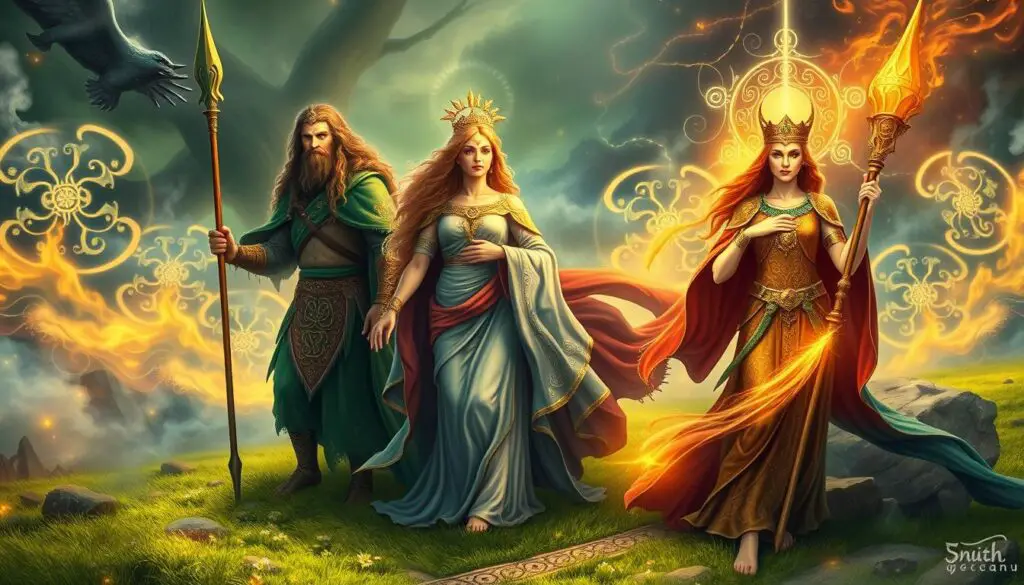
The Tuatha Dé Danann were magical beings in Irish stories. They were seen as gods before Christianity came. The Dagda, Morrígan, Lugh Lamhfada, Nuada Airgetlám, and Brigid were key in Irish culture and beliefs.
These Celtic gods were important in stories and showed what was valued in ancient Ireland. They stood for the best qualities of their time.
The Dagda
The Dagda was called the “good god.” He was a father figure and very powerful. He had a magical cauldron that made everyone happy and a club that could kill or bring back to life.
He was more than just a god. He protected and took care of his people.
The Morrígan
The Morrígan was a goddess of war and fate. She was known for her power and often took the form of a crow. She was linked to predicting doom and victory in fights.
Her mysterious and strong nature made her a key figure in Irish stories. She showed both the power to create and destroy.
Lugh
Lugh was known as Lugh of the Long Arm. He was great at war, making things, and in the arts. His spear was one of the four magical treasures brought by the Tuatha Dé Danann. It was unbeatable in battle.
Lugh was loved for his many talents. He was one of the most respected gods.
Nuada
Nuada was the first king of the Tuatha Dé Danann. He lost his hand in a fight but got a silver one instead. This showed his strength and wisdom.
Under Nuada’s leadership, the Tuatha Dé Danann won a big battle against the Fir Bolg. He was very important in their stories.
Brigid
Brigid was a goddess of fire and had many roles. She was into poetry, healing, and making things. Her many talents showed how important art and healing were in ancient Ireland.
Brigid could be a healer or a source of inspiration. She showed her power in many ways.
These figures from the Tuatha Dé Danann show the deep stories of Irish mythology. Each one had special powers and virtues. Learn more about their story and how they shaped Irish culture. Their stories still capture our imagination today.
The Four Treasures of the Tuatha Dé Danann
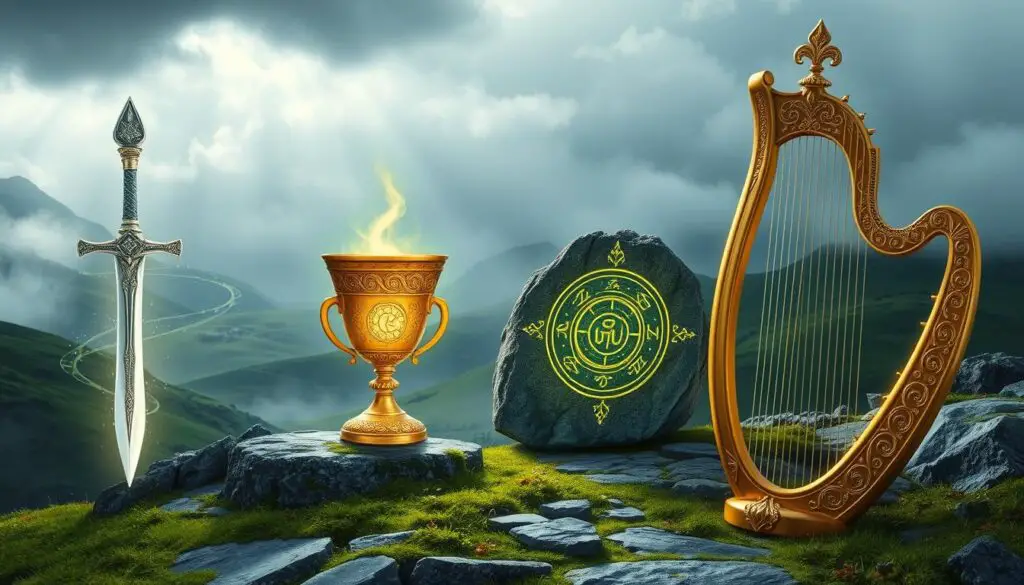
The Four Treasures of the Tuatha Dé Danann are very important in Irish stories. They show the power and wisdom of the Tuatha Dé Danann. These mythical artifacts came from the cities of Falias, Gorias, Findias, and Murias.
Stone of Fál
The Stone of Fál, also known as Lia Fáil, was in Tara. It would cry out when the true king of Ireland sat on it. This showed who was the real king.
Spear of Lugh
The Spear of Lugh was known for winning battles. Lugh, a hero, used it and was never beaten. It showed his great skill and strength.
Sword of Nuada
The Sword of Nuada made its owner unbeatable in fights. It was sure to kill anyone it hit. This sword showed the Tuatha Dé Danann’s bravery and strength.
The Dagda’s Cauldron
The Dagda’s Cauldron could feed everyone who ate from it. It showed the Tuatha Dé Danann’s kindness and plenty. This cauldron was a symbol of their caring nature.
The Four Treasures of the Tuatha Dé Danann show the big impact of Celtic mythology on Ireland. They tell us about the mythical artifacts that shaped Irish culture. For more info, check out this article on Irish Mythological Influence.
The Otherworld and Sídhe Mounds
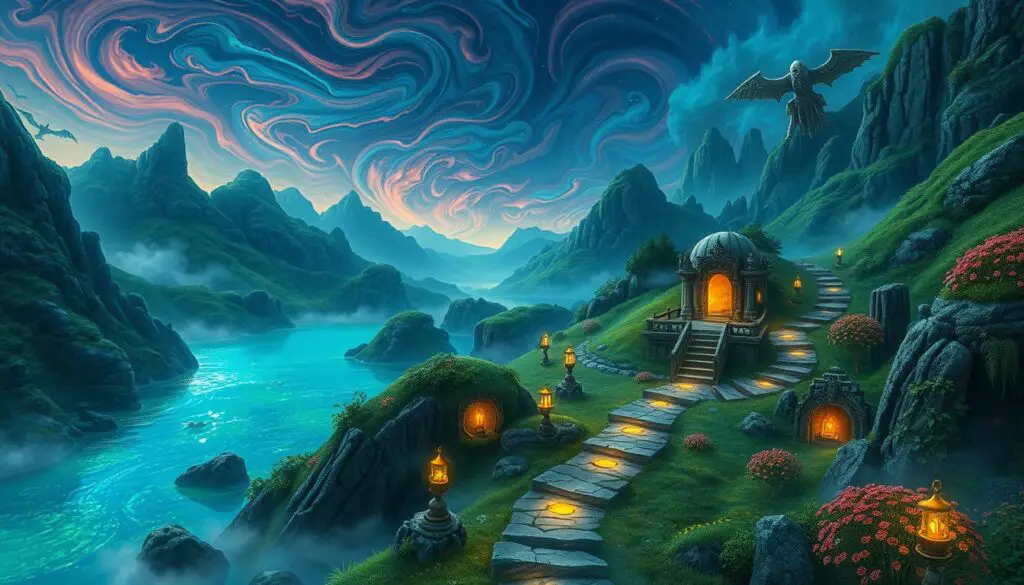
In Irish stories, the Otherworld is a place of endless youth and beauty. It’s full of health, plenty, and joy. Names like Tír na nÓg and Mag Mell show how rich the stories are.
This magical place is home to the Tuatha Dé Danann and some heroes. It’s not just a place but a world full of wonder.
People often met the Otherworld during Samhain and Beltane festivals. Heroes like Cúchulainn visited it through special tombs or by crossing rivers.
Concept of the Otherworld
The Otherworld was seen as a place of power in Irish tales. Kings got their right to rule from this place. Gods like Lugh played big roles here.
Donn, a god of death, and Tech Duinn, a place for souls, add to the Otherworld’s mystique. They make the stories even more interesting.
In Welsh stories, Arawn and Gwyn ap Nudd rule the Otherworld, called Annwn. This idea is also found in other Celtic stories, talking about journeys after death to sacred islands.
Today, writers like J. R. R. Tolkien and C. S. Lewis use these magical places in their stories. They bring the magic of Celtic myths to life.
Significance of Sídhe Mounds
Sídhe mounds like Newgrange were seen as doors to the Otherworld. They were more than stones; they were spiritual places. They linked the real and magical worlds together.
‘Sídhe’ means the mound’s people and is important in Irish and Scottish stories. There are many types of sídhe, like the bean sídhe and the fairy cat.
The Sídhe mounds show a deep cultural heritage. They tell us about the Tuatha Dé Danann and the magical Irish lands. They also show us the old religious beliefs.
Tales and Legends
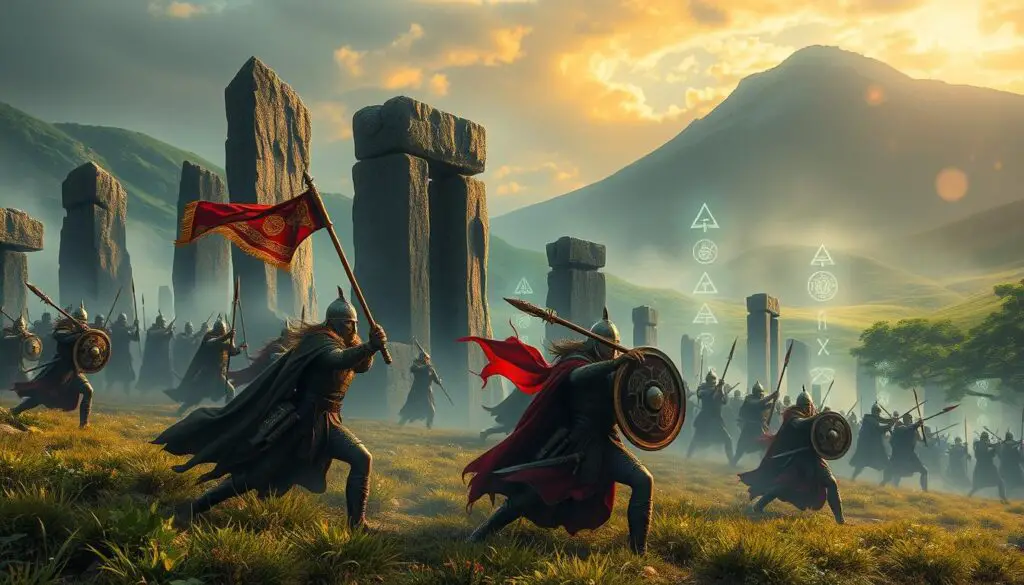
The stories of the Tuatha Dé Danann are full of heroic tales. They tell of bravery, wisdom, and magical adventures. These stories are key to Irish myths. They cover battles against the Fomorians and amazing feats at the Battle of Mag Tuired.
They came to Ireland after great journeys and settled here. Their stories tell of their conquests and their amazing items like the Sword of Nuada and the Spear of Lugh. These stories show their magical powers and how they shaped Ireland’s future.
Their culture was advanced, with bronze tools and horse-drawn chariots. This was far ahead of others who used copper. Their stories show their bravery and their big steps in culture and tech.
Heroic Deeds and Adventures
Their epic battles are famous. The Battle of Mag Tuired is a key event. They fought the Fir Bolg first and then the Fomorians, showing their skill and bravery.
Heroes like The Dagda and Lugh were key in these battles. Their actions set the stage for many Irish myths.
The Tuatha Dé Danann’s spirit shines in stories like the Fenian Cycle. Here, Finn MacCool’s adventures add to their legend. These stories highlight their bravery and teamwork, adding to Ireland’s folklore.
They also brought us the Brehon Laws, which teach about being kind and welcoming. Their social and cultural gifts still shape Ireland today. Their story of moving to Ireland connects with the country’s history, making their tales very important.
Transition to the Aes Sídhe
The Tuatha Dé Danann changed from old gods to the mystical Aes Sídhe. This change shows a big shift in Irish culture and beliefs. They became fairies, blending old pagan stories with new Christian beliefs.
Stories tell us the aos sídhe are ancient ancestors, magical beings, or even the souls of the dead. They are not just good or bad. They show the complex mix of old and new beliefs.
From Gods to Fairies
Once, the Tuatha Dé Danann were seen as powerful gods. They were known for their magic and bravery. Legends said they could heal, fight, and cast spells.
But over time, their stories changed. They became the aos sídhe, fitting into a new society and belief system. Some say they went to the Otherworld or lived in Sídhe mounds after losing battles. This change helped them stay in folklore, even when they were no longer seen as gods.
Integration into Gaelic Folklore
The Tuatha Dé Danann became famous as the Aes Sídhe in Gaelic stories. They became fairies, elves, and spirits, adding to Ireland’s rich myths. People still made offerings to them, showing they believed in their power over nature.
Their stories show how Irish myths have changed but stayed strong. The Tuatha Dé Danann’s legacy lives on as fairies and spirits in Irish stories. They are a big part of Ireland’s heritage and tales.
Frequently Asked Questions
Q: Do the Tuatha Dé Danann still exist?
In mythology, the Tuatha Dé Danann are said to have retreated into the otherworld, living invisibly alongside the human world. They remain a vital part of Celtic mythological stories.
Q: What does Tuatha Dé Danann look like?
The Tuatha Dé Danann are often depicted as beautiful and ethereal beings with a radiant appearance, sometimes described as tall with a commanding presence and magical aura.
Q: Are the Tuatha Dé Danann gods or fairies?
The Tuatha Dé Danann are considered a race of god-like beings or deities in Irish mythology, possessing supernatural powers and later became known as fairy folk in folkloric tales.
Q: Are Tuatha Dé Danann elves?
While not traditionally elves, some modern interpretations and fantasy literature might draw parallels between them and elves due to their magical nature and longevity.
Q: Who lived in Ireland before the Tuatha Dé Danann?
Before the Tuatha Dé Danann, Ireland was inhabited by the Fir Bolg, according to Irish mythology. The Tuatha Dé Danann then defeated them in the Battle of Moytura.
Q: What is the prophecy of the Tuatha Dé Danann?
Various prophecies concerning the Tuatha Dé Danann foretell their eventual return or resurgence in times of Ireland’s greatest need, signifying a rebirth of age-old wisdom and prosperity.
Q: Are the Tuatha Dé Danann evil?
In myths, the Tuatha Dé Danann are not typically depicted as evil; they are more often portrayed as powerful beings with a complex moral code and capable of both benevolence and wrath.
Q: What does the name Tuatha mean in English?
“Tuatha” is an Old Irish word meaning “people” or “tribe”, so Tuatha Dé Danann translates to “the tribe or people of the goddess Danu.”
Q: What were the physical description of the Tuatha Dé Danann?
Descriptions vary, but they are generally portrayed as majestic, often with light or pale skin, ethereal eyes, and sometimes silver hair, embodying the ideal of Celtic beauty.
Q: Who was the queen of the Tuatha Dé Danann?
The sovereignty of the Tuatha Dé Danann did not center around a queen in most legends, but rather kings and several prominent goddesses who played crucial roles in their society.
Q: What are the four gifts of the Tuatha Dé Danann?
The four magical gifts brought by the Tuatha Dé Danann to Ireland were the Stone of Fal, the Spear of Lugh, the Sword of Light of Nuada, and the Cauldron of the Dagda.
Q: Who are the enemies of the Tuatha Dé Danann?
Their enemies include the Fomorians, against whom they fought the epic battles, and later, the Milesians, who ultimately defeated them, leading to their retreat into the otherworld.


